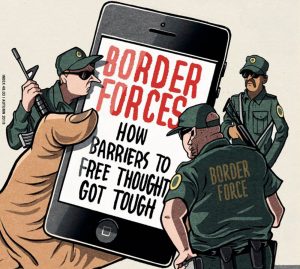17 Sep 2019 | Magazine, News and features, Volume 48.03 Autumn 2019
[vc_row][vc_column][vc_video link=”https://www.youtube.com/watch?v=ewRjZoRtu0Y&list=PLlUhPA3TuB56RH9Ly-mqvPHDVBHZ42gyL&index=3&t=0s”][vc_column_text]
Borders – not so great for free speech, but not so bad for music it turns out. This is the theme of our latest playlist, which ties in with the autumn 2019 Index on Censorship magazine. The magazine looks at how borders stop the flow of information, movement and speech, whether you be a South Korean wanting to be in touch with your loved ones in the north or an artist being denied a visa to perform in the UK. And we highlight how this trend is getting worse, specifically how border officials are demanding access to individuals’ social media accounts at frontiers around the world.
Enjoy the below songs. Just remember to be vigilant when crossing state lines. In fact for tips on how to keep your personal information just that – personal – click here.
[/vc_column_text][/vc_column][/vc_row][vc_row][vc_column][vc_column_text]

British-Sri Lankan rapper M.I.A has made a name for herself exploring the trials of life as a refugee through her music. The Sri Lankan government previously accused M.I.A of being a liar, while her song Paper Planes is inspired by her difficulties obtaining a visa to work in the USA, a problem Jan Fox highlights in her article. Despite her own trials she has stayed vigilant and continues to use her voice to call for political change.
“Every move you make, every step you take, I’ll be watching you,” sings Sting in the 1983 classic by English rock band The Police. His lyrics bare a striking resemblance to the theme of this issue, in which we reveal the extent to which border forces are snooping into your own personal information and data. Ela Stapley gives advice on what you can do to keep your information safe when crossing borders.
Australian electronic rock band Icehouse take you to a border crossing in their hit song from their album Measure for Measure. Against edgy beats and a dreamy synth, lead singer Iva Davies talks about walls standing still and freedom fading away, specifically at the border. It’s musical escapism on many levels.
Also known as Coming to America, this song written and performed by the legendary musician Neil Diamond in 1980 presents a positive depiction of immigrating to the USA. Flash forward to the USA of 2019 and Diamond might struggle to muster as much optimism. The increasing difficulties people face when trying to enter the USA are detailed in Mexican-based journalist Stephen Woodman’s article for the magazine.
Elton John tries to break down barriers – cultural, sexual – in this 1981 single. His lyrics have many connotations, with some alluding to his identity as a homosexual man and having to build a wall around his heart “to keep the pain away”. Unfortunately this is still the case for many LGBT people, who are having to hide their sexuality when crossing borders, something Mark Frary highlights in magazine piece “Hiding your true self”.
This signature song from The Doors illuminates the beauty of breaking on through to the other side. What that other side is has never been clarified, although given the drug references throughout the song it is probably safe to assume this is about psychedelic experiences. Drug references aside, the song’s lines about a country with “arms that chained us” and “eyes that lied” have universal implications that reverberate throughout the current issue.
A track that captures the tensions of 1969, when the war in Vietnam was intensifying and the threat of nuclear devastation from the Soviet Union painted a bleak future for the world. The desire to seek shelter is no less relevant today than it was when the Stones wrote this song. And it’s still inspiring art, as Irene Caselli shows in her article on artists trying to tell the stories of migrants in the Mediterranean.
It’s exactly what you think the song is about: a big two-fingered salute to the system. The politically charged lyrics express how the government gets to decide what is acceptable and what is not, just like some governments do today within a country and at its borders. Turkish contributing editor Kaya Genç reports on how travellers to Turkey are being restricted in what they can take into the country and what they can read. Wikipedia? Forget about it.
In this haunting track from Snow Patrol, lead vocalist Gary Lightbody and featured artist Martha Wainwright sing about being miles from their loved one and the pain that comes with such separation. It’s a feeling that is all too familiar for those in South Korea who have had their relationships and families torn apart by the North and South border, and who can face prison if they try to get in touch with them, as Steven Borowiec reports.
This choice is less about the song than the singer. Mozambique-musician Wazimbo is one of many artists who have had their UK visas denied this year. He was forced to pull out of an appearance at Peter Gabriel’s Womad Festival back in July as a result. Charlotte Bailey discusses Wazimbo in the magazine as she looks at how UK border policy is forcing artists to stop visiting the country, and how the UK’s cultural scene is losing out as a result.
[/vc_column_text][/vc_column][/vc_row][vc_row][vc_column][vc_basic_grid post_type=”post” max_items=”4″ element_width=”6″ grid_id=”vc_gid:1568990225205-426f193c-fdf1-1″ taxonomies=”7819″][/vc_column][/vc_row]
